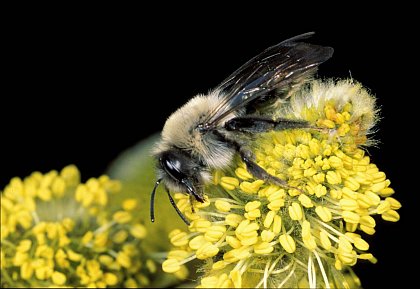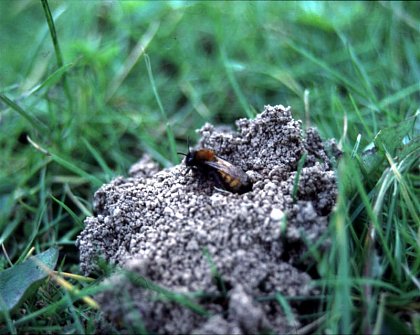Insect Conservation and Genetics
There is increasing support for the notion that we are experiencing a 6th mass extinction of life on earth, a direct consequence of our own destructive activities. Our studies are focused on understanding the demographic trends and genetic structure of insect species, with a view to reversing declines in insect biodiversity. One specific interest is the use of ‘diploid males’ as a measure of inbreeding in the Hymenoptera. Our current research uses RAD-sequencing to examine responses of bumble bees to climate change and to explore the genetic architecture of an extreme adaptation – long forelegs – to oil-collection in Rediviva bees of South Africa, funded by iDiv (http://www.idiv-biodiversity.de ).

Andrena vaga is a solitary, fossorial bee whose nests are threatened by river flooding

Andrena fulva, a common solitary bee of parks and gardens in Central and Northwest Europe
Key references
Kahnt, B., Montgomery, G.A., Murray, E., Kuhlmann, M., Pauw, A., Michez, D., Paxton, R.J. & Danforth, B.N. 2017. Playing with extremes: origins and evolution of exaggerated female forelegs in South African Rediviva bees. Molecular Phylogenetics and Evolution 115, 95-105. DOI: 10.1016/j.ympev.2017.07.025
McKendrick, L., Provan, J., Fitzpatrick, Ú., Brown, M.J.F., Murray, T.E., Stolle, E. & Paxton, R.J. 2017. Microsatellite analysis supports the existence of three cryptic species within the bumble bee Bombus lucorum sensu lato. Conservation Genetics 18, 573-584. DOI: 10.1007/s10592-017-0956-4
Soro, A., Quezada-Euan, J.J.G., Theodorou, P., Moritz, R.F.A. & Paxton, R.J. 2017. The population genetics of two orchid bees suggests high dispersal, low diploid male production and only an effect of island isolation in lowering genetic diversity. Conservation Genetics 18, 607-619. DOI: 10.1007/s10592-016-0912-8
Theodorou, P., Radzevičiūtė, R., Kahnt, B., Soro, A., Grosse, I. & Paxton, R.J. 2018. Genome-wide single nucleotide polymorphism scan suggests adaptation to urbanization in an important pollinator, the red-tailed bumblebee (Bombus lapidarius L.). Proceedings of the Royal Society B: Biological Sciences 285, 20172806. DOI: 10.1098/rspb.2017.2806
Our principal external collaborators
Prof. Javier Quezada , Autonomous University of Yucatan
Prof. Dr. Christoph Bleidorn , University of Göttingen
